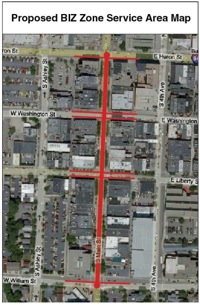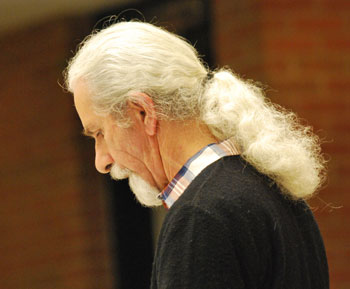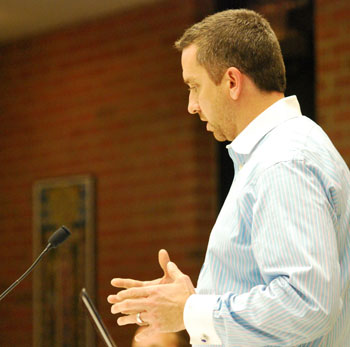Ann Arbor Main Street BIZ Clears Hurdle

Map of proposed BIZ area: Main Street from William Street in the south to Huron Street in the north. (Image links to complete .pdf file of the Main Street BIZ plan.)
On Wednesday, a cold and rainy evening, a group of downtown Ann Arbor property owners gathered in the city council chambers for a public meeting gaveled to order by the city clerk, Jackie Beaudry.
They were there not to discuss rain, but rather snow. At least in part.
On their agenda was consideration of a plan for a business improvement zone (BIZ) on Main Street – bounded by William Street to the south and Huron Street to the north – which would assess an extra tax on owners of property in the zone.
That plan for the BIZ includes snow removal as one of three main categories of services to be paid for through the BIZ. The other two categories of service in the plan are sidewalk cleaning and landscape plantings.
The plan was approved on a roll call vote of the property owners in attendance on Wednesday night, but not without some dissent. And the approval of the plan on Wednesday is not the final step before the BIZ can be implemented. Still ahead lies a formal public hearing by the city council, a vote by the city council, followed by another vote by property owners – this one by mail.
Background on the Ann Arbor Main Street BIZ
Almost exactly a year ago, the Ann Arbor Downtown Development Authority‘s partnerships committee reported out to the full board at its Dec. 3, 2008 meeting that Ed Shaffran and Ellie Serras had expressed an interest in creating a self-assessment zone centered on Main Street. They’d inquired about start-up funding, which would entail mostly a consultant and some legal work. Shaffran is a local developer and former chair of the DDA board. Serras is former executive director of the Main Street Area Association.

Ann Arbor city clerk Jackie Beaudry chaired the public meeting for property owners to vote on the business improvement zone proposed for Main Street between William and Huron. (Photo by the writer.)
And four months later, at its April 1, 2009 meeting, the DDA board authorized $83,270 to support the creation of a business improvement zone (BIZ) on South Main Street. The amount included roughly $75,000 plus a 10% contingency. A series of public meetings were held to pitch the idea to downtown property owners, including one at Conor O’Neill’s in June. [Chronicle coverage: "In the Business Improvement Zone"]
The series of public meetings resulted in submittal of a petition to the city clerk supporting the creation of the BIZ, signed by at least 30% of property owners in the district, where each signature is weighted based on the value of the property owned.
That weighting applies to all votes of property owners on matters related to the BIZ. The Ann Arbor city council also heard a presentation at an October work session on the proposed Main Street BIZ. [Chronicle Coverage: "Work Session: Trains, Trash, and Taxes."]
With the 30% petition submitted and a work session under its belt to get familiar with the notion of a BIZ, the city council then voted at its Oct. 19, 2009 meeting to move the BIZ along to the next step of its creation: the city clerk provided written notice to property owners of a public meeting to vote on the plan – which includes the budget and the formula for assessing property owners.
It was this vote that took place on Wednesday evening. It required a majority of property owners in attendance to pass – weighted based on the value of property they own. [For the state enabling legislation for a BIZ, see Public Act 120 of 1961].
Services Planned Through the Main Street BIZ
The services to be paid for through the Main Street BIZ are divided into two categories – those that are analyzed as providing a “direct benefit” to a property owner and those providing a “common benefit” to all property owners. The distinction between direct and common benefit services is important for the calculation of the tax owed by each property owner.
But first, what are the services?
The direct benefit services are sidewalk snow removal (budgeted at $60,000 per year) and sidewalk cleaning (budgeted at $10,000.) The common benefit services are landscape improvements and maintenance (budgeted at $12,000 a year).

Stephen Kelly questioned whether the cost of the snow removal was reasonable. (Photo by the writer.)
In response to a question from property owner Stephen Kelly and other property owners about what they perceived to be the excessively high cost allocated for snow removal, Ellie Serras explained that in getting estimates from potential snow removal contractors – names they had solicited from property owners in the proposed zone – they had specified: “We want Main Street to be like a hospital zone.”
More specifically, the snow removal service is triggered by accumulations of 1 inch or more, with provisions for the major accumulations of snow to be physically removed from the downtown area, not just shoveled into the street. The budgeted $60,000 covers up to 40 snowfalls per season.
The warm-weather equivalent of snow removal to be provided by the BIZ is sidewalk cleaning – weekly vacuuming of the sidewalks and semi-annual power washing. In addition, handbills will be removed weekly from public surfaces, and graffiti will be removed on demand. [For Chronicle coverage of Ann Arbor's relatively new graffiti ordinance: "Council OKs Graffiti Law, Questions AATA"]
The landscaping services – categorized as a common benefit – consist of contributing funds (budgeted at $12,000 per year) toward the maintenance of the 44 planter boxes within the district.
Calculating the Tax Owed: Direct versus Common Benefit
In addition to the common benefit service of landscaping, in the BIZ plan budget there are organizational expenses also categorized as common benefits to property owners of the district. Those organizational expenses are budgeted at $36,848 per year.
Broken down in terms of common benefit and direct benefit costs, then, the BIZ plan budget looks like this:
Direct Benefit Snow removal $60,000 Sidewalk Cleaning $10,000 Total Direct Benefit: $ 70,000 Common Benefit Landscaping $12,000 Organizational $36,848 Total Common Benefit $ 48,848 Total BIZ Budget $118,848
-
The assessment formula is designed to generate the $118,848 for the BIZ budget by considering the direct benefit costs and the common benefit costs separately.

Despite appearances, this is not a "lineal foot." Its owner did, however, attend the BIZ public meeting and voted yes on the BIZ plan. (Photo by the writer).
Direct benefit costs, so goes the reasoning, is a function of the amount of frontage along the area where the service is performed, measured in lineal feet. So the cost per lineal foot is calculated by taking the $70,000 in direct benefit costs and dividing by the 3,349 lineal feet of frontage in the zone to get an assessment rate of $20.90 per lineal foot.
The organizers of the BIZ reason that the common benefit costs are a function of the square footage of a property. So the cost per square foot is calculated by taking the $48,848 in common benefit costs and dividing by the 575,998 commercial square feet in the zone to get an assessment rate of $0.0848 per square foot.
So to calculate the tax owed by a property owner in the zone, the formula is:
Tax Owed = [Lineal Feet]*$20.90 +[Commercial Square Feet]*$0.0848
The average BIZ assessment of property owners in the zone, said Ed Shaffran, would be around $2,200.
Concerns Expressed by Property Owners
Besides the high costs associated with the snow removal, a concern was raised about the fairness of the distinction between direct costs and common costs. One point of confusion was whether the tax imposed by the BIZ would change based on changes in property value through time – the BIZ is specified to have a term of seven years. The BIZ tax uses the commercial square footage in its calculation, but not the assessed values of that commercial square footage. The role played by the commercial square footage owned by a property owner merely establishes the percentage of the total BIZ burden shouldered by that property owner.
Beyond the actual mechanics of how the BIZ would be administered, the main worry expressed by a few property owners was that the extra tax burden would be passed along to tenants – retailers on Main Street. The retail environment was repeatedly described as “fragile” and the fear was expressed that even a little extra burden could make the difference between surviving and failing.
One Tenant’s View
It was a tenant who actually argued most energetically for the BIZ – Chris DeRuyver of Affinity Wealth Solutions, a commercial tenant at 122 S. Main. DeRuyver would serve on the board of directors of the BIZ.
He described how snowy days inevitably led to cancellation of appointments – his clients would call to cancel, saying they didn’t want to trudge through the snow.
“Downtown is like a ghost town on snowy days,” DeRuyver said. He compared his previous experience working out of the 777 Building on Eisenhower, saying he never had cancellations due to snow, because the snow was always removed from the parking lot all the way to the door.
So DeRuyver said the BIZ would address a specific obstacle to the economic success of the Main Street area.
As for the concerns that some property owners had expressed about the additional expense of the tax threatening fragile businesses, he offered this advice: “In a down economy, you can’t be expense-driven; you have to be revenue-driven.”
The Vote
The Chronicle scored the roll call vote read out by city clerk Jackie Beaudry as 26 votes for the BIZ plan, with 2 votes against. Given that the votes had to be weighted by the value of property owned, the city assessor, David Petrak, was on hand to verify that the weighted majority had been achieved.
The next step is for the city council to hold a public hearing and a vote again on the BIZ – likely to happen in January 2010. Assuming approval by the city council, a final vote among property owners conducted by mail would then likely happen in February 2010. The first BIZ assessment would then be made in June 2010 and appear with the July tax bill. BIZ operations would commence in July 2010.





I’d love to keep a few of my tax dollars to use to remove snow from my sidewalk and a few more to give my house better curb appeal.
It’ll be a waste of money until the local business community and employers demand that the city clear All City streets in a timely manner. I live not 2 miles from Main Street (off Miller)and, sometimes, it will be 3 or 4 DAYS before a plow comes through. Even Miller Road can take 48 hours or more. I’ve lived in rural northern towns for decades and have never seen anything so poorly done as the street-clearing within the City of Ann Arbor. People won’t come shop, if they can’t get out their streets safely, I don’t. As our growing and new employers figure the expense of employee “snow days”, the failure to clear snow in a northern small town will drive more and more away. It’s an ESSENTIAL service for retaining and attracting business here (like water, electricity, public safety), and the business community should be jumping all over the city…city officials seem to be blithly ignoring individual’s complaints every year and continue to cut the snow clearing services.
“Given that the votes had to be weighted by the value of property owned, the city assessor, David Petrak, was on hand to verify that the weighted majority had been achieved.”
How so very 18th Century, your vote based on property ownership. Lol.
Sounds fair to me. The guys who benefit from the incremental service, pay for it. I’m not sure what the 18th century has to do with anything.
The snow-clearing expense is bases on an estimated 40 snowfalls?? Where do the estimators think we live, British Columbia??
Just curious – - $36,848 yearly for “organizational” costs. Could someone elaborate or break this down ? Thanks.
Re: [6]